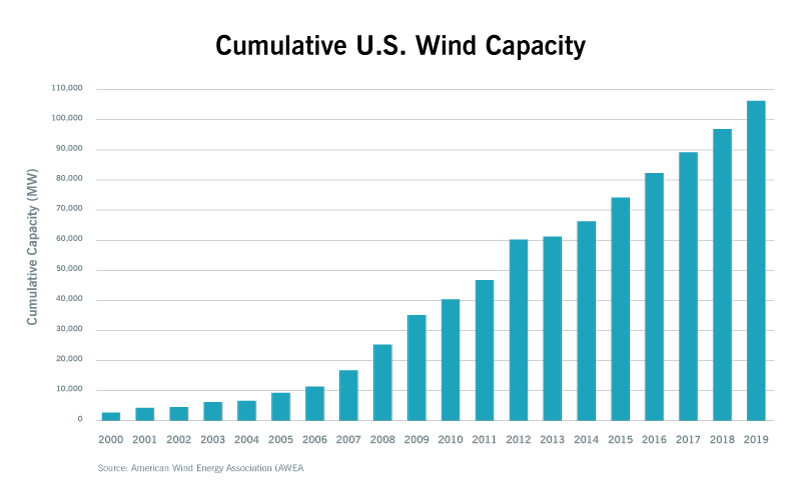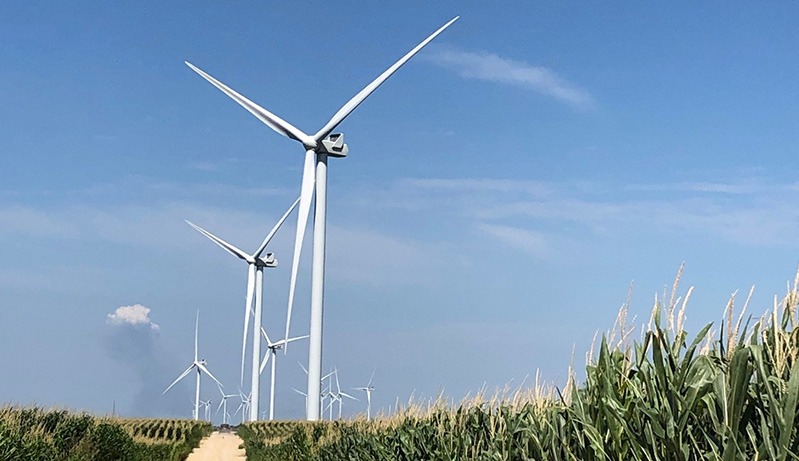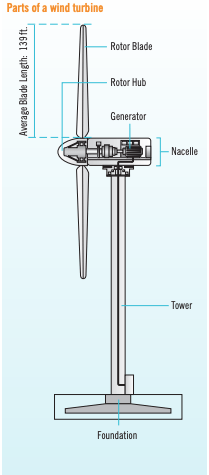What Is Wind Energy?
People have used the power of wind for thousands of years. Wind has moved boats along the Nile River, pumped water and milled grain, supported food production and much more. Today, the kinetic energy and power of natural air flows called wind are harnessed at massive scale to create electricity. A single, modern-day offshore wind turbine can generate more than 8 megawatts (MW) of energy, enough to cleanly power nearly six homes for a year. Onshore wind farms generate hundreds of megawatts, making wind energy one of the most cost-effective, clean and readily available energy sources on the planet.
Wind power is the lowest-cost large-scale renewable energy source and is the largest source of renewable energy in the U.S. today. There are nearly 60,000 wind turbines with a combined capacity of 105,583 megawatts (MW). That’s enough to power more than 32 million homes!

In addition to playing a vital role in our energy supply, wind energy solutions also help commercial companies meet renewable goals and mandates for dependable, clean energy.
The Advantages of Wind Energy:
- Wind turbines typically repay the lifetime carbon emissions associated with their deployment in less than a year, before providing up to 30 years of virtually carbon-free electricity generation.
- Wind energy helps reduce carbon dioxide emissions – in 2018, it avoided 201 million metric tons of C02 emissions.
- Wind energy provides tax revenue to communities that host projects. For example, state and local tax payments from wind projects in Texas totaled $237 million.
- The wind industry supports job creation, especially during construction. The industry supported 114,000 jobs across the U.S. in 2018.
- Wind energy provides a steady, supplemental source of revenue: Wind projects pay over $1 billion to state and local governments and private landowners each year.
What Does a Wind Power Project Look Like?
A wind project or farm refers to a large number of wind turbines that are built close together and function much like a power plant, sending electricity to the grid.

The Frontier Wind power I project in Kay County, Okla., has been operational since 2016 and is being expanded with the Frontier Wind power II project. Once complete, Frontier I and II will generate a total of 550 megawatts of wind energy – enough to power 193,000 homes.
How Do Wind Turbines Work?

Power is generated through rotating wind turbines that harness the kinetic energy of moving air, which is converted into electricity. The basic idea is that wind turbines use blades to collect wind’s potential and kinetic energy. Wind turns the blades, which spins a rotor that is connected to a generator to create electric energy.
Most wind turbines have four basic parts:
- Blades are attached to a hub, which spins as the blades turn. The blades and hub together make the rotor.
- The nacelle houses the gearbox, generator and electrical components.\
- The tower holds the rotor blades and generation equipment high above the ground.
- A foundation holds the turbine in place on the ground.
Types of Wind Turbines:
Big and small turbines fall into two basic categories, based on the orientation of the rotor: horizontal-axis and vertical-axis turbines.
Horizontal-axis turbines are by far the most commonly used type of wind turbine today. This type of turbine comes to mind when picturing wind power, with blades that look much like an airplane propeller. Most of these turbines have three blades, and the taller the turbine and the longer the blade, typically the more electricity is generated.
Vertical-axis turbines look much more like an eggbeater than an airplane propeller. The blades of these turbines are attached at both the top and bottom of a vertical rotor. Because vertical-axis turbines don’t perform as well as their horizontal counterparts, these are much less common today.
How Much Electricity Does a Turbine Generate?
It depends. The size of the turbine and the speed of the wind through the rotor blades determine how much electricity is produced.
Over the last decade, wind turbines have become taller, allowing for longer blades and the ability to take advantage of better wind resources available at higher heights.
To put things in perspective: A wind turbine with about 1 megawatt of power can produce enough clean energy for about 300 homes each year. Wind turbines used on land-based wind farms typically generate from 1 to nearly 5 megawatts. Wind speeds typically need to be approximately 9 miles per hour or more for most utility-size wind turbines to start producing electricity.
Each type of wind turbine is able to generate its maximum electricity within a range of wind speeds, often in between 30 and 55 miles per hour. However, if the wind is blowing less, production typically decreases at an exponential rate rather than stopping altogether. For example, the amount of energy generated decreases by a factor of eight if wind speed falls by half.
Should You Consider Wind Energy Solutions?
Wind power generation remains among the smallest carbon footprints of any energy source. It plays an essential role in the future of our nation’s energy supply, supporting our world’s energy transition and the increasing demand for sustainable energy resources.
Wind is also one of the best methods for corporations, universities, cities, utilities and other organizations to quickly shift to emissions-free energy at scale. One virtual power purchase agreement (VPPA) can secure tens to hundreds of megawatts of net zero electricity for 10 to 25 years. Most agreements also tick the box for additionality, meaning net-new clean energy sourcing displacing potentially older, higher-emitting energy sources.
What Is the Best Location for a Wind Energy Project?
There are six basic considerations for wind energy projects:
- Wind availability and desired locations
- Environmental impact
- Community input and local need for renewable energy generation
- Favorable policies at the state and federal levels
- Land availability
- Ability to connect to the power grid
Just like commercial solar PV projects, permits must also be secured before a wind power installation is started. This critical step will help determine if the project is financially viable and has a favorable risk profile. After all, the goal is to have the commercial-scale wind projects delivering electrons to the grid for decades to come. Assuring the builder AND project are financially sound will ensure success for a generation or more.
Post time: Jun-16-2021
